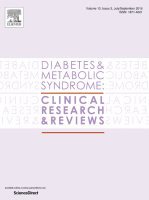Dyslipidemia and its risk factors among urban middle-aged Iranians: A population-based study
Authors
Affiliations
1Center for Health Related Social and Behavioral Sciences Research, Shahroud University of Medical Sciences, Shahroud, Iran.
2Department of Epidemiology, School of Public Health, Shahroud University of Medical Sciences, Shahroud, Iran.
3Noor Ophthalmology Research Center, Noor Eye Hospital, Tehran, Iran.
4Department of Epidemiology and Biostatistics, School of Public Health, Tehran University of Medical Sciences, Tehran, Iran. Electronic address: afotouhi@tums.ac.ir.
Abstract
Aims: Dyslipidemia is a known risk factor for cardiovascular disease and is a leading cause of mortality in developed and developing countries. This study was aimed to determine the prevalence of dyslipidemia and its risk factors in an urban group of Iranian adult population.
Methods: In this study, based on the criteria set by the National Cholesterol Education Program, the prevalence of dyslipidemia was evaluated in a population of 4737 people aged 45-69 years who participated in the second phase of an ophthalmology cohort study in Shahroud. Dyslipidemia prevalence was determined by age, sex, and risk factors of the disease; the findings were tested by using simple and multiple logistic regression.
Results: The prevalence of dyslipidemia was 66.5% (CI 95%: 64.4-68.6) in males, 61.3% (CI 95%: 59.5-63.2) in females, and 63.4% (CI 95%: 62.0-64.9%) in both sexes. The prevalence of hypertriglyceridemia, hypercholesterolemia, low HDL-C, and high LDL-C, respectively, was 28.8%, 13.4%, 42.3%, and 13.4%, respectively. In multivariate logistic regression model, increase of age (for females), abdominal obesity, overweight and obesity, hypertension, and diabetes were associated with an increased odd of dyslipidemia.
Conclusion: The prevalence of dyslipidemia in middle-aged urban population in Iran is high, and with increasing age there is an increased risk of dyslipidemia. Hence, considering the growing trend of aging in Iran, there is need for taking special measures to deal with dyslipidemia as a health priority. Furthermore, the need for planning in order to reduce the risk of dyslipidemia and prevent its complications is greater than ever.
Keywords: Dyslipidemia; Iran; Population-based study; Prevalence; Risk factor.

